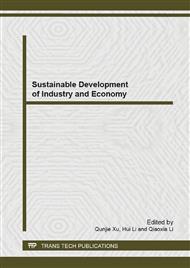[1]
Ma, S.J., Wang, R.S. The Social-economic-natural Complex Ecosystem. Acta Ecol. 1(1984), pp.1-9.
Google Scholar
[2]
Guan, Y.Z. Study on the Index System for Constructing Ecological—a Case Study on Fujian Province. Journal of Fujian Teachers University (Natural Science). 4(2002), pp.100-104.
Google Scholar
[3]
Bian, Y.S., He, J. The Study on Standards of Ecological, Eco-city and Eco-county. Engineering Science. 11(2003), pp.22-28.
Google Scholar
[4]
State Environment Protection Administration of China. The National Plan for Ecological Environment Construction. Beijing (1998).
Google Scholar
[5]
State Environment Protection Administration of China. Construction Indicators of Eco-county, Eco-city and Eco-province (revised). Beijing (2007).
Google Scholar
[6]
Zhang, K.M., Weng, Z.G. Progress on indicators of urban ecologically sustainable development. Urban Environment& Urban Ecology. 6(2001), pp.1-4.
Google Scholar
[7]
Turnhout E., Hisschemoller M., Eijsackers H. Ecological Indicators: Between the Two Fires of Science and Policy. Ecological Indicators. 7(2007), pp.215-228.
DOI: 10.1016/j.ecolind.2005.12.003
Google Scholar
[8]
Olsen LM, Dale V.H., Foster T. Landscape Patterns as Indicators of Ecological Change at Fort Benning, Georgia, USA. Landscape and Urban Planning, 9(2007), pp.137-149.
DOI: 10.1016/j.landurbplan.2006.02.007
Google Scholar
[9]
Lin, T., Xue, X.Z., Lu, C.Y. Methods for Developing a Net Shape Ecological Indicator System and Assigning Rational Weights to the Indicators. Acta Ecol. 1(2007), pp.235-241.
Google Scholar
[10]
Fu, B.J., Liu. S. L., Ma. K.M. The Contents and Methods of Integrated Ecosystem Assessment (IEA). Acta Ecol. Sin. 12(2001), pp.1885-1892.
Google Scholar
[11]
Lin. T., Lin. J.Y., Cui. S.H., Cameron S. Using a Network Framework to Quantitatively Select Ecological Indicators. Ecological Indicator. 9 (2009), pp.1114-1120.
DOI: 10.1016/j.ecolind.2008.12.009
Google Scholar
[12]
Felix M., Regina H.K., Hubert W. Indicating Ecosystem Integrity – Theoretical Concepts and Environmental Requirements. Ecological Modeling. 130(2000), pp.13-23.
DOI: 10.1016/s0304-3800(00)00210-6
Google Scholar
[13]
Niemeijer D., De Groot R.S. A Conceptual Framework for Selecting Environmental Indicator Sets. Ecological indicators. 8(2008), pp.14-25.
DOI: 10.1016/j.ecolind.2006.11.012
Google Scholar
[14]
Bondad-Reantaso M G, Prein M. Measuring the Contribution of Small-scale Aquaculture: an Assessment. Rome, FAO(2009).
Google Scholar
[15]
Bowen R.E., Riley C. Socio-economic Indicators and Integrated Coastal Management. Ocean and Coastal Management 46(2003), p.299–312.
DOI: 10.1016/s0964-5691(03)00008-5
Google Scholar
[16]
Lin. T., Xue. X.Z., Lu. C.Y. Analysis of Coastal Wetland Changes by using DPSIR model: a Case Study in Xiamen China. Coastal Management. 25(2007), pp.289-303.
DOI: 10.1080/08920750601169592
Google Scholar
[17]
Dale V.H., Beyeler S.C. Challenges in the Development and Use of Ecological Indicators. Ecological Indicators. 1(2001), pp.3-10.
DOI: 10.1016/s1470-160x(01)00003-6
Google Scholar
[18]
Lin, J.Y., Lin, T., Cui, S.H. Quantitative Selection Model of Ecological Indicators and Its Solving method. Ecological Indicator. 13 (2012), pp.294-302.
DOI: 10.1016/j.ecolind.2011.06.024
Google Scholar


